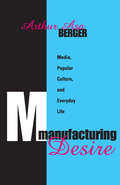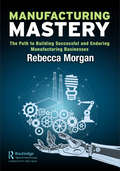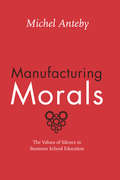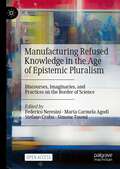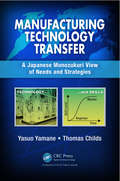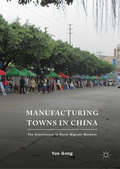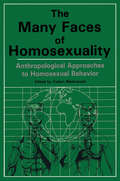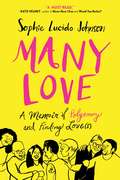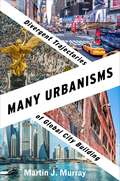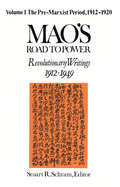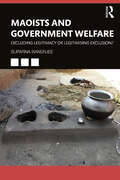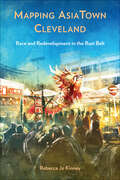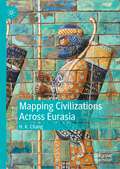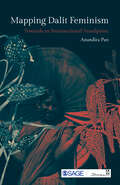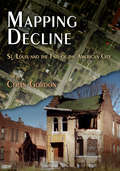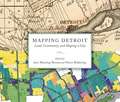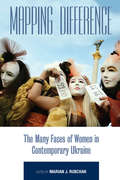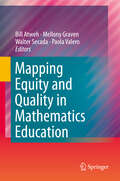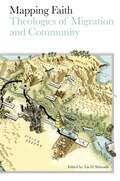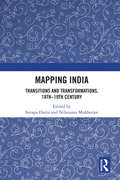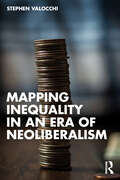- Table View
- List View
Manufacturing Desire: Media, Popular Culture, and Everyday Life
by Arthur Asa BergerThe average person in America watches four hours of television per day and spends the equivalent of nine years of his or her life in front of the television set. If the attention most people devote to popular culture - listening to the news, watching soap operas, reading the comics-were added up, it would reveal that most people spend an enormous amount of time with popular culture which becomes in large measure, their culture. "Manufacturing Desire" is a study of how the mass media broadcast or spread various popular arts; further how the media and popular arts play a major role in shaping our everyday lives.The television shows we watch, the movies we see, the radio programs we listen to, and all the comic strips we read influence social behavior. They give us ideas about what is good and evil, about how to solve problems, and about how we should relate to others. If we understand this, says Berger, then the way we think about our media-influenced culture will be far different than if we see popular culture as mindless entertainment. Berger provides an analysis of the way popular culture and the mass media simultaneously reflect and affect various aspects of American culture and society. He examines commercials, television shows, comics, film, humor, and everyday life in terms of what beliefs and values are found in them, what attitudes toward ourselves, and our societies are contained in them, how they achieve their effects, and what they reflect about present-day American culture and society.This book is analysis of the impact mass media have across America, cross-culturally, and internationally. "Manufacturing Desire" will provide the general reader as well as specialists in communication and information, sociology, and psychology with a better understanding of the effects of mass media and popular culture on contemporary society.
Manufacturing Mastery: The Path to Building Successful and Enduring Manufacturing Businesses
by Rebecca MorganWhile there are those who say manufacturing is dying, it is not and will not. Without a universal vow of poverty, growing economies will only increase demand. Manufacturing in the 21st century is not a question of if -- Rather, it is a function of why, what, who, where, and how. The nature and pace of change in those factors are overwhelming many. Fear, futile resistance, and uncertainty are common. While manufacturing will not die, individual manufacturing companies will if they do not learn to thrive in this new world. This book is a dynamic guide for manufacturing leaders who want to reduce the ambiguity and overwhelming changes and develop a realistic, progressive, and responsive thinking process that enables success. It provides a business operating system framework that is the foundation for connecting the many pieces of a manufacturing business into an effective, profitable operation. The author walks through the elements, relationships, capabilities, and mutability 21st-century manufacturing requires. Executives of manufacturing companies will be better able to think about and execute viable strategies leveraging the changing economy. Essentially, manufacturing is becoming increasingly complex, as are business and socioeconomic and political realities. Rapidly evolving technology adds to the confusing environment that precludes “more of the same, better, faster and cheaper” as a workable business strategy. The tsunami of information hitting owners and leaders is overwhelming many, and it is easy to become frozen in place. Economic growth and improving standards of living require that all of this change be broken into bite-size understandable pieces that thaw the minds of executives, allowing them to assess what is best right now, and move forward. This book does not overwhelm with details and models; rather it provides thinking and examples in small chunks that enable manufacturers to develop and master skills for high-level strategic leadership in ambiguity.
Manufacturing Mastery: The Path to Building Successful and Enduring Manufacturing Businesses
by Rebecca MorganWhile there are those who say manufacturing is dying, it is not and will not. Without a universal vow of poverty, growing economies will only increase demand. Manufacturing in the 21st century is not a question of if -- Rather, it is a function of why, what, who, where, and how. The nature and pace of change in those factors are overwhelming many. Fear, futile resistance, and uncertainty are common. While manufacturing will not die, individual manufacturing companies will if they do not learn to thrive in this new world. This book is a dynamic guide for manufacturing leaders who want to reduce the ambiguity and overwhelming changes and develop a realistic, progressive, and responsive thinking process that enables success. It provides a business operating system framework that is the foundation for connecting the many pieces of a manufacturing business into an effective, profitable operation. The author walks through the elements, relationships, capabilities, and mutability 21st-century manufacturing requires. Executives of manufacturing companies will be better able to think about and execute viable strategies leveraging the changing economy. Essentially, manufacturing is becoming increasingly complex, as are business and socioeconomic and political realities. Rapidly evolving technology adds to the confusing environment that precludes “more of the same, better, faster and cheaper” as a workable business strategy. The tsunami of information hitting owners and leaders is overwhelming many, and it is easy to become frozen in place. Economic growth and improving standards of living require that all of this change be broken into bite-size understandable pieces that thaw the minds of executives, allowing them to assess what is best right now, and move forward. This book does not overwhelm with details and models; rather it provides thinking and examples in small chunks that enable manufacturers to develop and master skills for high-level strategic leadership in ambiguity.
Manufacturing Morals: The Values of Silence in Business School Education
by Michel AntebyCorporate accountability is never far from the front page, and as one of the world's most elite business schools, Harvard Business School trains many of the future leaders of Fortune 500 companies. But how does HBS formally and informally ensure faculty and students embrace proper business standards? Relying on his first-hand experience as a Harvard Business School faculty member, Michel Anteby takes readers inside HBS in order to draw vivid parallels between the socialization of faculty and of students. In an era when many organizations are focused on principles of responsibility, Harvard Business School has long tried to promote better business standards. Anteby's rich account reveals the surprising role of silence and ambiguity in HBS's process of codifying morals and business values. As Anteby describes, at HBS specifics are often left unspoken; for example, teaching notes given to faculty provide much guidance on how to teach but are largely silent on what to teach. Manufacturing Morals demonstrates how faculty and students are exposed to a system that operates on open-ended directives that require significant decision-making on the part of those involved, with little overt guidance from the hierarchy. Anteby suggests that this model--which tolerates moral complexity--is perhaps one of the few that can adapt and endure over time. Manufacturing Morals is a perceptive must-read for anyone looking for insight into the moral decision-making of today's business leaders and those influenced by and working for them.
Manufacturing Refused Knowledge in the Age of Epistemic Pluralism: Discourses, Imaginaries, and Practices on the Border of Science
by Simone Tosoni Federico Neresini Maria Carmela Agodi Stefano CrabuThis open access book explores contemporary practices that challenge science, arguing that this matter cannot be simply disregarded as a new manifestation of “anti-scientism”. It scrutinizes the processes through which knowledge claims, refused by established institutions and the scientific community, seek legitimacy. Assuming an agnostic analytical stance, it explores the actors involved in such processes and their social worlds, their interactions with epistemic institutions, and the ways in which they enact such refused knowledge in their daily lives. Drawing on a three-year mixed-method research project, this collection demonstrates how refused knowledge can be seen as a distinct mode of knowing, employed in response to the uncertainties of everyday life. Thus, it offers a deeper understanding not only of how refused knowledge garners credibility, but also of how knowledge at large – including scientific knowledge – emerges from specific sociotechnical assemblages.
Manufacturing Technology Transfer: A Japanese Monozukuri View of Needs and Strategies
by Yasuo Yamane Tom ChildsBased on a bestselling book originally published in Japanese, Manufacturing Technology Transfer: A Japanese Monozukuri View of Needs and Strategies offers time-tested methods and little-known tips for achieving successful transfer of technology along with the skills required to operate that technology. Designed to support a series of lectures on technology transfer within a master’s course on the management of technology, it presents the results of years of research carried out at Hiroshima University.The book delves into the authors’ decades of experience transferring technology between Japan and the rest of the world, particularly to developing countries from where much of the world’s future economic growth is expected. It contains case studies of successful technology transfers from both the ship building and food equipment industries. Its wide-reaching coverage examines methods of skill transfer, production management, and manufacturing company classification.Introducing readers to the engineering activities that occur within the manufacturing industry, the book illustrates the engineering technology activities involved in manufacturing, along with the production management activities required to support them. It also explains how job simulators can help shorten learning times in the manufacturing industry in the same way that flight simulators are used to teach flying skills to pilots.The book outlines a framework for teaching and learning processes that can be visualized in terms of an S-shaped learning curve. It explains how technology transfer overseas should be supported by contractual agreements between the parties concerned. Detailing the legal/contractual responsibilities for all parties involved, it also describes what you should do if problems arise during the transfer.Integrating previously unpublished research results with illustrative case studies, this book is suitable for a wide audience within the manufacturing industry—including manufacturing engineering students in both developed and developing countries, those responsible for the development of manufacturing engineers in industry and elsewhere, and anyone interested in the international activities of Japanese manufacturing companies.
Manufacturing Technology Transfer: A Japanese Monozukuri View of Needs and Strategies
by Yasuo Yamane Tom ChildsBased on a bestselling book originally published in Japanese, Manufacturing Technology Transfer: A Japanese Monozukuri View of Needs and Strategies offers time-tested methods and little-known tips for achieving successful transfer of technology along with the skills required to operate that technology. Designed to support a series of lectures on technology transfer within a master’s course on the management of technology, it presents the results of years of research carried out at Hiroshima University.The book delves into the authors’ decades of experience transferring technology between Japan and the rest of the world, particularly to developing countries from where much of the world’s future economic growth is expected. It contains case studies of successful technology transfers from both the ship building and food equipment industries. Its wide-reaching coverage examines methods of skill transfer, production management, and manufacturing company classification.Introducing readers to the engineering activities that occur within the manufacturing industry, the book illustrates the engineering technology activities involved in manufacturing, along with the production management activities required to support them. It also explains how job simulators can help shorten learning times in the manufacturing industry in the same way that flight simulators are used to teach flying skills to pilots.The book outlines a framework for teaching and learning processes that can be visualized in terms of an S-shaped learning curve. It explains how technology transfer overseas should be supported by contractual agreements between the parties concerned. Detailing the legal/contractual responsibilities for all parties involved, it also describes what you should do if problems arise during the transfer.Integrating previously unpublished research results with illustrative case studies, this book is suitable for a wide audience within the manufacturing industry—including manufacturing engineering students in both developed and developing countries, those responsible for the development of manufacturing engineers in industry and elsewhere, and anyone interested in the international activities of Japanese manufacturing companies.
Manufacturing Towns in China: The Governance Of Rural Migrant Workers
by Yue GongThis book offers an engaging and unique view of the governance of Chinese rural migrants in non-factory areas of manufacturing towns. By asking how authorities govern migrants as an ongoing source of cheap labor, this book demonstrates and interprets authorities’ power exercised in the form of governing rationalities, regulations, programs, activities, and designated non-factory spaces—town and village centers and migrant living zones. These power exercises take place routinely in migrants’ everyday lives but typically veil themselves, producing knowledge that legitimates our understanding of migrants. Based on their power exercises, authorities’ governance of migrants, like multiple “invisible filters” that select and help create migrant labor in non-factory areas, leads to an inclusion of a certain number of migrants as cheap factory workers and an exclusion of the rest. Nevertheless, by exercising their unique power techniques, migrants can resist and alter authority governance; thus the authorities’ power exercises are deficient and may ultimately be futile. This book details these power exercises, offers rewarding insights, and can greatly enrich our understanding of China’s local governance of migrants and migrant resistance.
Many Faces Of Homosexuality: Anthropological Approaches To Homosexual Behavior
by Evelyn BlackwoodThis groundbreaking book examines the diverse manifestations of homosexuality in various historical periods and non-Western cultures. The distinguished authors examine Kimam male ritualized homosexual behavior, Mexican homosexual interaction in public contexts, male homosexuality and spirit possession in Brazil, and much more.
Many Love: A Memoir of Polyamory and Finding Love(s)
by Sophie Lucido JohnsonSophie Lucido Johnson gets a lot of questions when she tells people that she’s polyamorous. Many Love is an intimate look at this often misunderstood practice: its history, its misconceptions, and Sophie’s personal transformation from serial monogamist to proud polyamorist.After trying for years to emulate her boomer parents’ forty-year and still-going-strong marriage, Sophie realized that maybe the love she was looking for was down a road less traveled. In this bold, graphic memoir, she explores her sexuality, her values, and the versions of love our society accepts and practices. Along the way, she shares what it’s like to play on Tinder side-by-side with your boyfriend, encounter—and surmount—many types of jealousy, learn the power of female friendship, and other amazing things that happened when she stopped looking for “the one.” In a lot of ways, Many Love is Sophie’s love letter to everyone she has ever cared for. Witty, insightful, and complete with illustrations, this debut provides a memorable glimpse into an unconventional life.
Many Urbanisms: Divergent Trajectories of Global City Building
by Martin J. MurrayNow, for the first time in history, the majority of the world’s population lives in cities. But urbanization is accelerating in some places and slowing down in others. The sprawling megacities of Asia and Africa, as well as many other smaller and medium-sized cities throughout the “Global South,” are expected to continue growing. At the same time, older industrial cities in wealthier countries are experiencing protracted socioeconomic decline. Nonetheless, mainstream urban studies continues to treat a handful of superstar cities in Europe and North America as the exemplars of world urbanism, even though current global growth and development represent a dramatic break with past patterns.Martin J. Murray offers a groundbreaking guide to the multiplicity, heterogeneity, and complexity of contemporary global urbanism. He identifies and traces four distinct pathways that characterize cities today: tourist-entertainment cities with world-class aspirations; struggling postindustrial cities; megacities experiencing hypergrowth; and “instant cities,” or master-planned cities built from scratch. Murray shows how these different types of cities respond to different pressures and logics rather than progressing through the stages of a predetermined linear path. He highlights new spatial patterns of urbanization that have undermined conventional understandings of the city, exploring the emergence of polycentric, fragmented, haphazard, and unbounded metropolises. Such cities, he argues, should not be seen as deviations from a norm but rather as alternatives within a constellation of urban possibility. Innovative and wide-ranging, Many Urbanisms offers ways to understand the disparate forms of global cities today on their own terms.
Mao's Road to Power: Revolutionary Writings, 1912-49 (An\east Gate Book Ser. #Vol. 1)
by Stuart Schram Zedong MaoRevolution in its Leninist guise has been a dominant force in the world for most of the 20th century, and the Chinese revolution has been, with the Russian revolution, one of its two most important manifestations. Mao Zedong, the architect of victory in China in 1949, stands out as one of the dominant figures of the century. Guerilla leader, strategist, conqueror, ruler, poet and philosopher, he placed his imprint on China, and on the world. Even though today communism is widely seen as bankrupt, Mao Zedong's achievements as an innovative disciple of Lenin and Stalin in the most populous nation on earth guarantees his place in history. Whatever the ultimate fate of communism in China, the fact of Mao's influence on events during more than five decades, and its resonance after his death, will remain. This edition of Mao Zedong's writings provides abundant documentation in his own words regarding his life and thought. It has been compiled from all available Chinese sources, including not only the 20-volume edition published in Tokyo years ago, but many new materials issued in China since 1978, both openly and for internal circulation. The editors have pursued a threefold goal: firstly, to translate every text by Mao which could be obtained, so as to make this English version as complete as possible; secondly, to annotate the materials in sufficient detail to make them accessible to the non-specialist reader; and thirdly, to combine accuracy with a level of literary quality which is intended to make the volumes agreeable as well as instructive to read. Volume 1 includes translations of the entire contents of the authoritative "Mao Zedong Zaoqi Wengao 1912.6-1920.11" ("Draft writings from Mao Zedong's early period, June 1912-November 1920"), published in Beijing in 1990, plus some 15 additional texts for the same period which have been attributed to Mao. Among the items thus made available in English are his first surviving work, a middle school essay of 1912 in praise of Shang Yang; his very extensive "Classroom Notes" of late 1913 on the lectures of his most influential teachers, Yang Changji and "Yuan the Big Beard"; a dozen letters to his then close friend Xiao Zisheng (Siao-yu), who described a shared odyssey in "Mao-Tse-tung and I were Beggars"; his marginal annotations of 1918 to the German philosopher Friedrich Paulsen's work on ethics, in which Mao proclaimed himself a believer in "individualism" and an admirer of Nietzsche; and many important letters, articles, and other writings documenting his evolution from liberalism to anarchism and finally to Marxism in 1919-1920.
Maoists and Government Welfare: Excluding Legitimacy or Legitimising Exclusion?
by Suparna BanerjeeThis book systematically analyses state responses towards Maoism in India and studies the role of state policies in prolonging conflict. It looks at how the structural maladies that once gave rise to conflict have now found a place in the government responses meant to address it. The book studies the socio-political conditions of Adivasis and lower caste groups that make up large sections of the cadre and highlights the exclusionary nature of the Indian political landscape. It discusses various themes such as state legitimacy, the political landscape through exclusion, the agency of Maoist foot soldiers, limitations of government welfare responses, and the idea of the marginalised in India. Rich in empirical data, the book will be useful for scholars and researchers of development studies, political studies, political sociology, minority studies, exclusion studies, sociology and social anthropology. It will also be of interest to policy-makers.
Mapping AsiaTown Cleveland: Race and Redevelopment in the Rust Belt (Asian American History & Cultu)
by Rebecca Jo KinneyCleveland, Ohio is not a location that most people associate with Asian American placemaking. However, on Cleveland’s East Side, multigenerational and panethnic Asian American residents and business owners are building community in the AsiaTown neighborhood. Mapping AsiaTown Cleveland foregrounds the importance of region in racial formation and redevelopment as it traces the history of racial segregation and neighborhood diversity. Mapping AsiaTown Cleveland challenges ideas about the invisibility of Asian Americans in the urban Midwest by linking the contemporary development of Cleveland’s “AsiaTown” to the multiple and fragmented histories of Cleveland’s Asian American communities from the 1940s to present day. Kinney’s sharp insights illustrate how region matters for Japanese Americans who resettled from concentration camps and Chinese Americans food purveyors, as well as the ways in which Asian American community leaders have had to fight for visibility and representation in city planning—even as the Cleveland Asian Festival is branded as a marquee “diversity” event for the city. Mapping AsiaTown Cleveland recognizes the vibrant Asian American community formations and belonging that have developed in seemingly unexpected spaces and places. In the series Asian American History and Culture
Mapping Civilizations Across Eurasia
by H. K. ChangThis book is a history reader and cultural primer for students and aspiring scholars of past and contemporary interactions among civilizations over the Eurasian landmass. Tracing a human journey that spans several million years, this general survey of civilizations comprises seven sections: Studies on Civilization, Silk Road, Survey of Greater Central Asia, Portrait of India, Persian Cultural Sphere, Caucasus, and Turkish March. The first section introduces methodologies and perspectives for civilization studies. The second focuses on the concept and connotations of the ancient Silk Road as well as China's 21st-century strategic Belt & Road Initiative. In the remaining five sections, the trilingual, peripatetic author, based on his experiences and reflections, provides introductions to and comments on the history, literature, art, social tensions, and future development of five key areas along the Silk Road, i.e., Central Asia, India, Iran, Caucasus, and Turkey.
Mapping Dalit Feminism: Towards an Intersectional Standpoint
by Anandita PanIn this path-breaking study, a first in many ways, Anandita Pan argues that dalit women are an intersectional category, simultaneously affected by caste and gender. The use of intersectionality permits observation of the ways in which different forms of discrimination combine and overlap, challenging the apparent homogeneity of the categories ‘woman’ and ‘dalit’ as seen by mainstream Indian Feminism and Dalit Politics. This points to the difference between women and dalit women and the latter with dalit men, which leave them unrepresented. The book investigates the questions of ‘selfhood’, identity, representation and epistemology which reveal the ‘savarnanization’ of ‘Indian woman’ and the masculinization of ‘dalit’. There is an incisive discussion of knowledge produced about dalit women and the intervention and contribution of Dalit Feminism therein. The book concludes with the question of who can be or become a dalit feminist, intriguingly, not a limited category.
Mapping Decline
by Colin GordonOnce a thriving metropolis on the banks of the Mississippi, St. Louis, Missouri, is now a ghostly landscape of vacant houses, boarded-up storefronts, and abandoned factories. The Gateway City is, by any measure, one of the most depopulated, deindustrialized, and deeply segregated examples of American urban decay. "Not a typical city," as one observer noted in the late 1970s, "but, like a Eugene O'Neill play, it shows a general condition in a stark and dramatic form."Mapping Decline examines the causes and consequences of St. Louis's urban crisis. It traces the complicity of private real estate restrictions, local planning and zoning, and federal housing policies in the "white flight" of people and wealth from the central city. And it traces the inadequacy--and often sheer folly--of a generation of urban renewal, in which even programs and resources aimed at eradicating blight in the city ended up encouraging flight to the suburbs. The urban crisis, as this study of St. Louis makes clear, is not just a consequence of economic and demographic change; it is also the most profound political failure of our recent history.Mapping Decline is the first history of a modern American city to combine extensive local archival research with the latest geographic information system (GIS) digital mapping techniques. More than 75 full-color maps--rendered from census data, archival sources, case law, and local planning and property records--illustrate, in often stark and dramatic ways, the still-unfolding political history of our neglected cities.
Mapping Detroit: Land, Community, and Shaping a City (Great Lakes Books Series)
by June Manning Thomas Henco BekkeringOne of Detroit's most defining modern characteristics--and most pressing dilemmas--is its huge amount of neglected and vacant land. In Mapping Detroit: Land, Community, and Shaping a City, editors June Manning Thomas and Henco Bekkering use chapters based on a variety of maps to shed light on how Detroit moved from frontier fort to thriving industrial metropolis to today's high-vacancy city. With contributors ranging from a map archivist and a historian to architects, urban designers, and urban planners, Mapping Detroit brings a unique perspective to the historical causes, contemporary effects, and potential future of Detroit's transformed landscape. To show how Detroit arrived in its present condition, contributors in part 1, Evolving Detroit: Past to Present, trace the city's beginnings as an agricultural, military, and trade outpost and map both its depopulation and attempts at redevelopment. In part 2, Portions of the City, contributors delve into particular land-related systems and neighborhood characteristics that encouraged modern social and economic changes. Part 2 continues by offering case studies of two city neighborhoods--the Brightmoor area and Southwest Detroit--that are struggling to adapt to changing landscapes. In part 3, Understanding Contemporary Space and Potential, contributors consider both the city's ecological assets and its sociological fragmentation to add dimension to the current understanding of its emptiness. The volume's epilogue offers a synopsis of the major points of the 2012 Detroit Future City report, the city's own strategic blueprint for future land use. Mapping Detroit explores not only what happens when a large city loses its main industrial purpose and a major portion of its population but also what future might result from such upheaval. Containing some of the leading voices on Detroit's history and future, Mapping Detroit will be informative reading for anyone interested in urban studies, geography, and recent American history.
Mapping Difference: The Many Faces of Women in Contemporary Ukraine
by Marian J. RubchakDrawn from various disciplines and a broad spectrum of research interests, these essays reflect on the challenging issues confronting women in Ukraine today. The contributors are an interdisciplinary, transnational group of scholars from gender studies, feminist theory, history, anthropology, sociology, women's studies, and literature. Among the issues they address are: the impact of migration, education, early socialization of gender roles, the role of the media in perpetuating and shaping negative stereotypes, the gendered nature of language, women and the media, literature by women, and local appropriation of gender and feminist theory. Each author offers a fresh and unique perspective on the current process of survival strategies and postcommunist identity reconstruction among Ukrainian women in their current climate of patriarchalism.
Mapping Equity and Quality in Mathematics Education
by Paola Valero Mellony Graven Bill Atweh Walter SecadaConcerns about quality mathematics education are often posed in terms of the types of mathematics that are worthwhile and valuable for both the student and society in general, and about how to best support students so that they can develop this mathematics. Concerns about equity are about who is excluded from the opportunity to develop quality mathematics within our current practices and systems, and about how to remove social barriers that systematically disadvantage those students. This collection of chapters summarises our learning about the achievement of both equity and quality agendas in mathematics education and to move forward the debate on their importance for the field.
Mapping Experiences
by James KalbachCustomers who have inconsistent experiences with products and services are understandably frustrated. But it's worse for organizations that can't pinpoint the causes of these problems because they're too focused on processes. This updated book shows your team how to use alignment diagrams to turn valuable customer observations into actionable insight. With this powerful technique, you can visually map existing customer experience and envision future solutions.Designers, product and brand managers, marketing specialists, and business owners will discover how experience diagramming helps you determine where business goals and customer perspectives intersect. Armed with this insight, you can provide the people you serve with real value. Mapping experiences isn't just about product and service design; it's about understanding the human condition.Emphasize recent changes in business using the latest mapping techniquesCreate diagrams that account for multichannel experiences as well as ecosystem designUnderstand how facilitation is increasingly becoming part of mapping efforts, shifting the focus from a deliverable to actionabilityExplore ways to apply mapping of all kinds to noncommercial settings, such as helping victims of domestic violence
Mapping Experiences: A Guide to Creating Value through Journeys, Blueprints, and Diagrams
by James KalbachCustomers who have inconsistent, broken experiences with products and services are understandably frustrated. But it's worse when people inside these companies can't pinpoint the problem because they're too focused on business processes. This practical book shows your company how to use alignment diagrams to turn valuable customer observations into actionable insight. With this unique tool, you can visually map your existing customer experience and envision future solutions.Product and brand managers, marketing specialists, and business owners will learn how experience diagramming can help determine where business goals and customer perspectives intersect. Once you're armed with this data, you can provide users with real value.Mapping Experiences is divided into three parts:Understand the underlying principles of diagramming, and discover how these diagrams can inform strategyLearn how to create diagrams with the four iterative modes in the mapping process: setting up a mapping initiative, investigating the evidence, visualizing the process, and using diagrams in workshops and experimentsSee key diagrams in action, including service blueprints, customer journey maps, experience maps, mental models, and spatial maps and ecosystem models
Mapping Faith: Theologies of Migration and Community
by David Mason Sheila Curran Ruth Padel Alison Phipps Ibrahim Mogra Faiza Omar Ric Stott Oliver Joseph Katy Radford Julie Khovacs Ivan Khovacs Hassan Rabbani Katherine Baxter Yvonne Green Tawona Sithole Rachel Godfrey Sofia Rehman Michael Nausner Robyn Ashworth-Steen Sayed Razawi Jacqueline Nicholls Aviva Dautch Pádraig Ó Tuama Harvey Kwiyani Hajra Williams Sally Style Mohamed Omar Jennifer Langer Issam Kourbaj Nazneen Ahmed Amir DarwishThis enlightening edited collection shows how migration shapes the lives of faith communities - and vice versa - through diverse prisms including diaspora, generational change, cultural conflict, conceptions of 'ministry' and artistic response. The contributors comprise writers, poets and artists from the three largest Abrahamic faiths (Judaism, Christianity, Islam) and beyond. They show how issues of migration are addressed through a variety of different media such as theological debate and shared community action, poetry and art.As issues of migration are an important factor in so many political and social debates, faith communities are looking for guidance on how to deepen their theological understanding of migration. This book helps them to reflect on their own practices and experiences, learn from their own traditions and engage in dialogue with diverse communities.
Mapping India: Transitions and Transformations, 18th–19th Century
This book presents an alternate history of colonial India in the 18th and the 19th centuries. It traces the transitions and transformations during this period through art, literature, music, theatre, satire, textiles, regime changes, personal histories and migration. The essays in the volume examine historical events and movements which questioned the traditional parameters of identity and forged a new direction for the people and the nation. Viewing the age through diverse disciplinary angles, the book also reflects on the various reimaginings of India at the time. This volume will be of interest to academics and researchers of modern Indian history, cultural studies and literature. It will also appeal to scholars interested in the anthropological, sociological and psychological contexts of imperialism.
Mapping Inequality in an Era of Neoliberalism
by Stephen ValocchiOffering a unique, comprehensive, and critical introduction to increasingly visible social inequalities, this textbook examines the political and economic causes and cultural consequences of a stratifying system that allocates material resources and human dignity on the basis of private profit and labor exploitation.Mapping Inequality in an Era of Neoliberalism foregrounds capitalism as the major source of the power relations in the United States, as a class system that serves the dominant vector of inequality and sets the parameters of social mobility. The book starts with racialized capitalist power and shows how this power is constituted in structures of opportunity and constraint. It also uses ethnographic accounts to “flip the script” to show how individuals in the class structure construct identities.Providing students with tools for understanding, Valocchi engagingly introduces many of the crucial concepts in this area of sociology – power, opportunity structures, ideology, social and cultural capitals, and intersectional class identities – connecting them as part of a uniquely critical approach.
